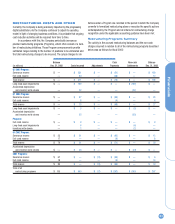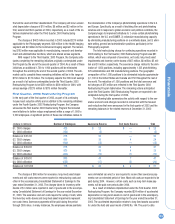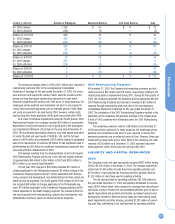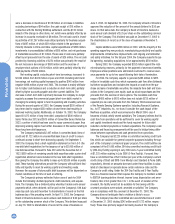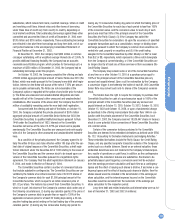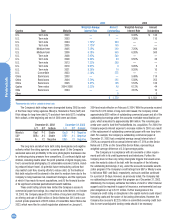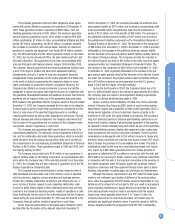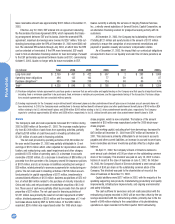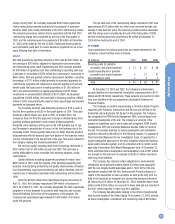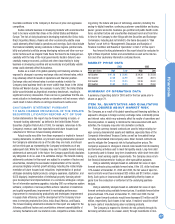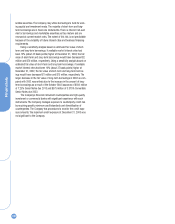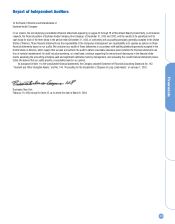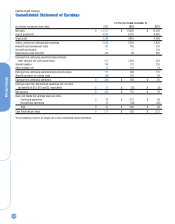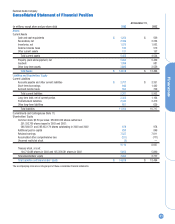Kodak 2003 Annual Report Download - page 32
Download and view the complete annual report
Please find page 32 of the 2003 Kodak annual report below. You can navigate through the pages in the report by either clicking on the pages listed below, or by using the keyword search tool below to find specific information within the annual report.
Financials
32
(in millions) Total 2004 2005 2006 2007 2008 2009+
Long-term debt $ 2,759 $ 457 $ 422 $ 507 $ 2 $ 283 $ 1,088
Operating lease obligations 494 125 103 77 59 43 87
Purchase obligations(1) 985 266 238 124 98 80 179
Total(2) $ 4,238 $ 848 $ 763 $ 708 $ 159 $ 406 $ 1,354
(1) Purchase obligations include agreements to purchase goods or services that are enforceable and legally binding on the Company and that specify all significant terms,
including: fixed or minimum quantities to be purchased; fixed, minimum or variable price provisions; and the approximate timing of the transaction. Purchase obliga-
tions exclude agreements that are cancelable without penalty.
(2) Funding requirements for the Company’s major defined benefit retirement plans and other postretirement benefit plans are not included as such amounts have not
been determined. In 2003, the Company made contributions to its major defined benefit retirement plans and other postretirement benefit plans of $149 million ($24
million relating to its U.S. defined benefit plans) and $248 million ($245 million relating to its U.S. other postretirement benefits plan), respectively. The Company
expects to contribute approximately $5 million and $258 million, respectively, to its U.S. defined benefit plans and other postretirement benefit plans in 2004.
2002
The Company’s cash and cash equivalents increased $121 million during
2002 to $569 million at December 31, 2002. The increase resulted prima-
rily from $2,204 million of cash flows from operating activities, partially
offset by $758 million of cash flows used in investing activities and
$1,331 million of cash used in financing activities.
The net cash provided by operating activities of $2,204 million for
the year ended December 31, 2002 was partially attributable to (1) net
earnings of $770 million which, when adjusted for depreciation and amor-
tization, and restructuring costs, asset impairments and other charges,
provided $1,673 million of operating cash, (2) a decrease in accounts
receivable of $263 million, (3) a decrease in inventories of $88 million, (4)
proceeds from the surrender of its Company-owned life insurance policies
of $187 million, and (5) an increase in liabilities excluding borrowings of
$29 million, related primarily to severance payments for restructuring pro-
grams. The net cash used in investing activities of $758 million was uti-
lized primarily for capital expenditures of $577 million, investments in
unconsolidated affiliates of $123 million, business acquisitions of $72 mil-
lion, of which $60 million related to the purchase of minority interests in
China and India, and net purchases of marketable securities of $13 mil-
lion. These uses of cash were partially offset by proceeds from the sale of
properties of $27 million. The net cash used in financing activities of
$1,331 million was primarily the result of net debt repayments of $597
million, dividend payments of $525 million and the repurchase of 7.4 mil-
lion Kodak shares held by KRIP for $260 million. Of the $260 million
expended, $205 million was repurchased under the 1999 stock repur-
chase program, which is now completed. The balance of the amount
expended of $55 million was repurchased under the 2000 stock repur-
chase program.
Net working capital, excluding short-term borrowings, decreased to
$474 million at December 31, 2002 from $797 million at December 31,
2001. This decrease is primarily attributable to an increase in accounts
payable and other current liabilities, an increase in accrued income taxes,
lower receivables and lower inventories partially offset by a higher cash
balance.
On April 11, 2002, the Company’s Board of Directors declared a
semi-annual cash dividend of $.90 per share on the outstanding common
stock of the Company. This dividend was paid on July 16, 2002 to share-
holders of record at the close of business on June 3, 2002. On October
10, 2002, the Company’s Board of Directors declared a semi-annual cash
dividend of $.90 per share on the outstanding common stock of the
Company. This dividend was paid to the shareholders of record at the
close of business on December 13, 2002.
Capital additions were $577 million in 2002, with the majority of the
spending supporting new products, manufacturing productivity and quality
improvements, infrastructure improvements, and ongoing environmental
and safety initiatives.
The cash outflows for severance and exit costs associated with the
restructuring charges recorded in 2002 will be more than offset by the tax
savings associated with the restructuring actions, primarily due to the tax
benefit of $46 million relating to the consolidation of its photofinishing
operations in Japan recorded in the third quarter 2002 restructuring
lease receivable amount was approximately $367 million at December 31,
2003.
Effective July 22, 2003, ESF entered into an agreement amending
the Receivables Purchase Agreement (RPA), which represents the financ-
ing arrangement between ESF and its banks. Under the amended RPA
agreement, maximum borrowings were lowered to $257 million. Total out-
standing borrowings under the RPA at December 31, 2003 were $248 mil-
lion. The amended RPA extends through July 2004, at which time the RPA
can be extended or terminated. If the RPA were terminated, ESF would
need to find an alternative financing solution for new borrowings. Pursuant
to the ESF partnership agreement between Qualex and DCC, commencing
October 6, 2003, Qualex no longer sells its lease receivables to ESF.
Qualex currently is utilizing the services of Imaging Financial Services,
Inc., a wholly owned subsidiary of General Electric Capital Corporation, as
an alternative financing solution for prospective leasing activity with its
customers.
At December 31, 2003, the Company had outstanding letters of cred-
it totaling $121 million and surety bonds in the amount of $113 million
primarily to ensure the completion of environmental remediations and
payment of possible casualty and workers’ compensation claims.
As of December 31, 2003, the impact that our contractual obligations
are expected to have on our liquidity and cash flow in future periods is as
follows:



